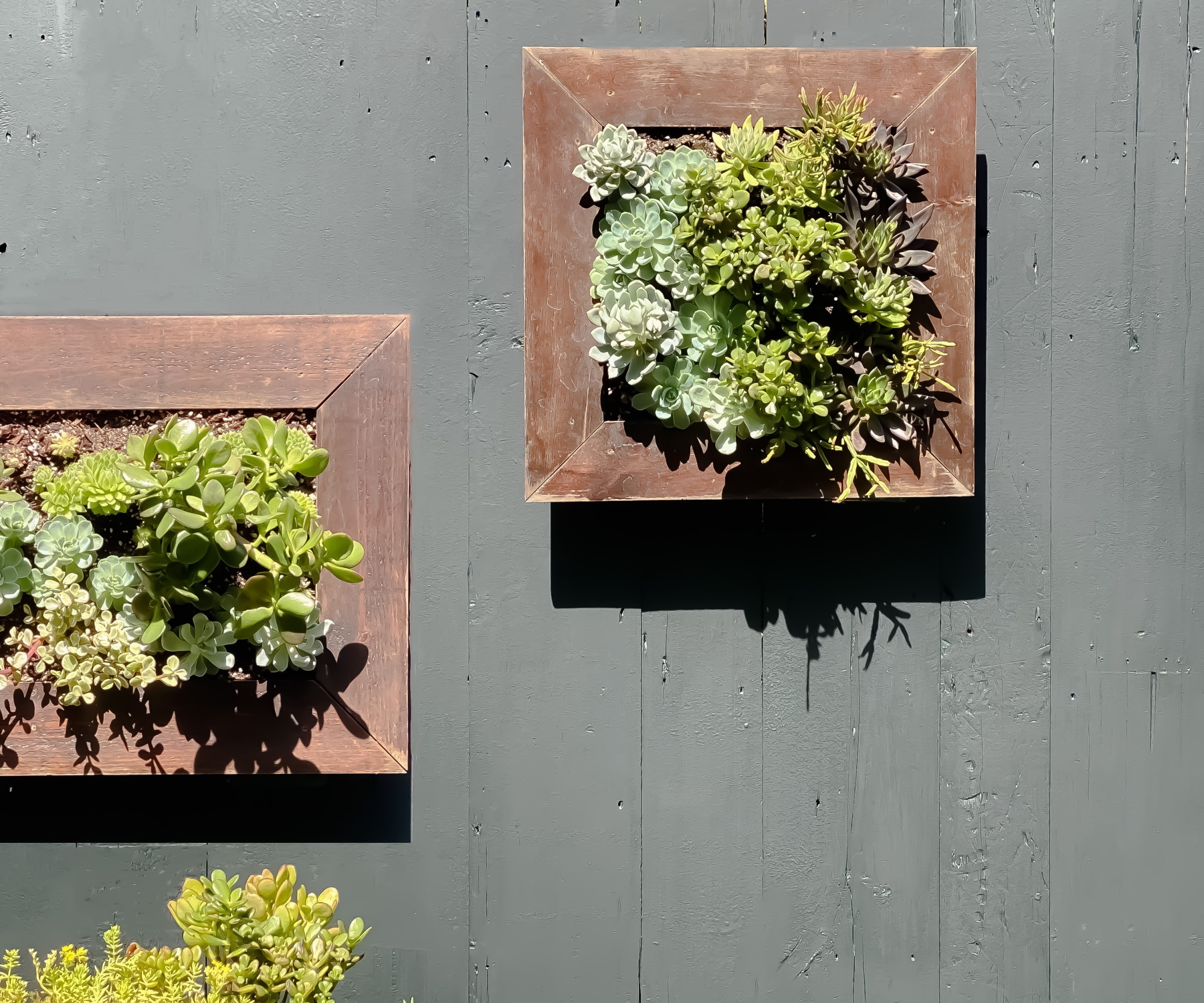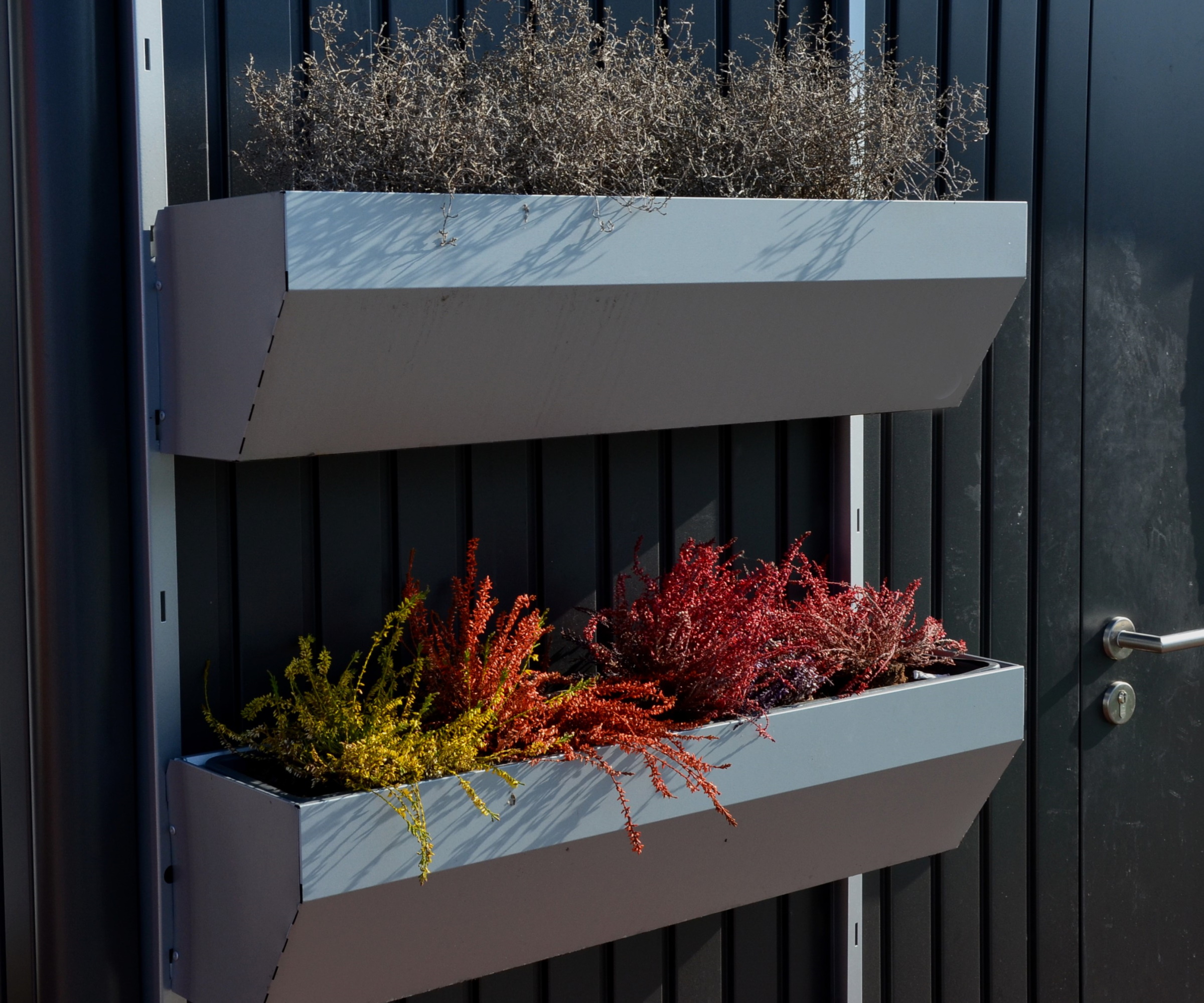How to create a vertical garden – DIY advice for building a living wall
Small backyards or terraces need not be a problem, as vertical gardening can help to add different levels of interest to any outside space


When considering small backyard ideas, many gardeners seek to grow as many plants as possible but struggle for space. Urban backyards can often be ungenerous, either narrow or small in size, and sometimes even a tiny terrace is something to be grateful for.
Fortunately, many vertical options for urban gardeners can help those wanting to add greenery to their outside space, whatever the size of the plot. Growing upwards, or growing vertically, can help to maximize growing space by utilizing wall space as well as growing in flower beds.
There are many different vertical garden ideas, some more complex and costly than others. Here, we discuss DIY living wall ideas, with practical advice that will help you decide what to build and how to do it.

How to create a vertical garden
Creating a living wall need not be complicated. Here, we share practical advice that will help you to create a vertical garden, maximizing the space in your yard.
What is a vertical garden?

A vertical garden, also known as a green wall or living wall, 'involves growing plants vertically on a structure or wall rather than in traditional horizontal gardens,' says Autumn Hilliard-Knapp, horticulture specialist at Perfect Plants Nursery.
'This space-saving technique allows for a lush and visually appealing garden using vertical surfaces,' Autumn adds. Indeed, living walls are a brilliant way to add more plant life to a small yard, especially for those looking for novel garden wall ideas.
Living walls are generally made up of plants grown in containers or trays, sometimes hung or grown on shelves, as can be seen in the image above. Importantly, 'vertical gardens can feature a variety of plant types, such as plants for a flowering living wall, herbs, vegetables, and succulents, and provide benefits like improved air quality and noise reduction,' Autumn continues.
Design expertise in your inbox – from inspiring decorating ideas and beautiful celebrity homes to practical gardening advice and shopping round-ups.
While this is a useful and practical way to maximize growth in a small yard, there are practicalities for those considering how to create a vertical garden.

Autumn is a plant expert and marketing professional at Perfect Plants Nursery. With four years of experience in the horticulture industry, she has developed a passion for helping people create beautiful indoor and outdoor spaces to enjoy. Her expertise in horticulture encompasses a broad range of activities, including plant care and selection, landscape design, and maintenance.
How do I maintain a vertical garden?

Firstly, living walls need a lot of maintenance to keep them looking lush and green. As the growing material - soil - is limited, plants will not do as well when grown in trays and small pots as they would if grown in the ground. Regular maintenance, particularly adding in new plants and incorporating new soil, will be crucial to keep your living wall looking good.
If you are thinking about creating a living wall near the side of your property or against a garden wall, there is a risk of water damage if the living wall isn’t correctly installed. Drainage is important, but ensuring that water is directed away from buildings and structures is critical.
For example, for those seeking unique garden fence ideas, installing a living wall atop a garden fence can lead to water damage to the wooden fence, if built incorrectly. If you are unsure about how to do this, it is recommended that you seek professional help from a landscaper. Nevertheless, it is possible to create living fences.
Finally, living walls that are near windows and doors will attract bees and other insects, which is great for encouraging biodiversity and wildlife in your yard, but this might result in more sightings of insects and pollinators venturing indoors, especially during the spring and summer months.
Should I build or buy a living wall structure?

Whether you build or buy a living wall will depend on a variety of factors, not least if you have a penchant for DIY or not. If you enjoy garden-building projects and you are looking for backyard ideas on a budget, consider using spare materials, such as wooden pallets, to build your own vertical garden.
This option is only recommended for those who are confident in their DIY capabilities and for those knowledgeable about home-build projects. As mentioned already, living walls that are placed near or on fences or walls can cause damage to existing structures. The weight of your proposed living wall is something to consider, as is drainage and water damage.
If you opt to build a living wall out of wood, using a wooden pallet, for example, it is recommended that you stain the wood, to help protect against water damage as much as possible. In addition, lining your trays and shelves with an impermeable membrane is a good idea, and using a perforated pipe to drain the water in a suitable direction, away from walls and fences.
There are many cost-effective living wall options available to buy that might appeal to you, more so than the thought of getting the toolbox out. Vertical planters made of lightweight fabric are quick and easy to install, and suitable for those gardening in an apartment or for those looking for backyard ideas for kids. Productive plants including strawberries, squash and cucumber can easily be grown in vertical planters, making for a fun family project this summer. This is also suitable for those asking how to garden in a rental property, as these options are quick to install and cost-effective.

The hanging wall plant bag is a great space-saving solution for those wanting to garden vertically. It can be hung on railings, walls, and it can be used to plant strawberry, vegetables, foliage plant, hanging plants. Multi-pockets design for practical planting practice. Made of felt material, light and easy to carry and durable.
Which plants work best for a vertical garden?

There are many ways to plant a living wall. Using a combination of evergreens and annuals is recommended, as well as growing different foliage and flowering plants that will guarantee interest across different seasons.
Always plant for your situation, growing perennials and annuals that are suitable for your specific US hardiness zone, as well as the amount of light or shade in your yard. For shady corners, ferns and hostas will do well in a living wall, while for those in a sunny spot, flowering annuals are a good pick.
Incorporating climbing or trailing plants, dependent on the size of your living wall, can also help to fill out the space. 'Star jasmine, available at Perfect Plants, is a beautiful climbing plant that features an abundance of delicate white flowers and glossy, dark evergreen foliage,' says Autumn. 'It is popular for its sweet fragrance and ability to grow quickly, making it perfect for covering walls.'
In addition, 'climbing hydrangeas, available at Nature Hills, are usually a crowd favorite,' says Whitney Laritson, Merchandising & Content Manager at Nature Hills. While they are 'slow to establish, after a few years they get going, filling your green walls with attractive foliage.'
Alternatively, growing fruit and vegetables vertically can be effective in smaller yards. Tomatoes, for example, will happily ramble along a living wall, growing well alongside herbs and flowering annuals in a sunny spot. Much the same, for those wondering how to grow cucumbers vertically, this summer fruiting crop can be an ideal plant to grow within a living wall, and provide delicious fruits right up until fall.
You can even create an indoor living wall, for example by using houseplants you can mount.

Whitney Laritson is a garden expert and the Merchandising & Content Manager at Nature Hills. For the last 20 years, Nature Hills has been passionate about providing high-quality plants you can count on.

This felt wall planter is a versatile way to have beautiful flowers or a herb garden almost anywhere. Each pocket is 6 inches deep by 5 inches wide and 4 inches extended outwards. The felt allows the roots of your plants to breathe and prevents mold. This planter is perfect for small areas such as apartment balconies.
FAQs
Can I build a living wall indoors?
Yes, living walls are suitable for a variety of plants and situations, including growing indoors. Vertical planting modules and trays that are intended for indoor use are available to buy online, with adequate drainage and growing space. Incorporating plenty of drainage material is important when growing in a living wall indoors.
Creating a vertical garden is an effective way to maximize growing space in any yard. For more space-saving ideas, consider square-foot gardening, a unique approach to growing fruit and vegetables in small outside spaces, which can help you raise a variety of crops in smaller plots.

Thomas is a Content Editor within the Gardens Team at Homes and Gardens. He has worked as a professional gardener for both public spaces and private estates, specializing in productive gardening, growing food and flowers. Trained in Horticulture at the Garden Museum, he has written on gardening and garden history for various publications, including The English Garden, Gardens Illustrated, Hortus, The London Gardener and Bloom. He has co-authored a Lonely Planet travel book, The Tree Atlas, due out in 2024.